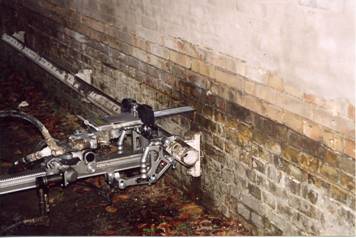
Rising damp
Building Type 1: 1850-1890
Many brick-built basement walls and foundations in older properties are moisture-laden as a result of ground moisture rising over a period of many years. In addition to the mortar joints suffering from slow washout, the brickwork often suffers from major salt precipitation, which is especially detrimental to the appearance of the walls, and at the same time results in the basement area becoming more or less unusable due to the damp environment.
There are numerous methods for halting or limiting the rise and penetration of moisture. The most effective means of preventing the capillary absorption of ground moisture in the brickwork is to introduce a horizontal barrier in the form of tar paper or stainless steel sheets. The barrier can be introduced either by sawing through the wall with a diamond chainsaw or by using special equipment to tap it in. Common to each method is that it is challenging to carry out and requires specially trained operators who are also able to assess which method will be the best in each individual case.
In many cases the sawing method will require a cutting plan to ensure that the building does not settle and crack. The cutting plan will often be prepared by a building engineer. There are also a number of chemical-based treatments.
In addition, see SBi: Fugt i bygninger (Moisture in Buildings), GI: Fugt (Moisture) and BYG-ERFA: Kældre og krybekældre (Basements and Crawl Spaces)
Photos: COWI A/S